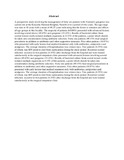| dc.contributor.author | Ayumba, B R | |
| dc.contributor.author | Magoha, G A | |
| dc.date.accessioned | 2013-02-22T05:53:48Z | |
| dc.date.issued | 1998-06 | |
| dc.identifier.citation | East Afr Med J. 1998 Jun;75(6):370-3 | en |
| dc.identifier.uri | http://erepository.uonbi.ac.ke:8080/xmlui/handle/123456789/10672 | |
| dc.identifier.uri | | |
| dc.identifier.uri | http://www.ncbi.nlm.nih.gov/pubmed/9803623 | |
| dc.description.abstract | A prospective study involving the management of forty six patients with Fournier's gangrene was carried out at the Kenyatta National Hospital, Nairobi over a period of two years. The age range was nine to 81 years with a mean of 40.27 years indicating that the lesion is common and affects all age groups in this locality. The majority of patients (60.86%) presented with advanced lesions involving scrotal ulcers (45.65%) and gangrene (15.22%). Results of bacterial culture from scrotal wound swabs isolated multiple organisms in 8.15% of the patients, a point which should be taken into consideration during antibiotic selection. Forty one patients (89.13%) had surgical procedures in addition to antibiotics and other supportive measures. Five other patients (10.87%) who presented with early lesions had medical treatment only with antibiotics, antipyretics and analgesics. The average duration of hospitalisation was sixteen days. Two patients (4.35%) one of whom was HIV positive died from septicaemia during the study period. Recurrent scrotal infection occurred in two patients (4.35%) after discharge from the hospital and were treated satisfactorily at the surgical outpatient clinic.presented with advanced lesions involving scrotal ulcers (45.65%) and gangrene (15.22%). Results of bacterial culture from scrotal wound swabs isolated multiple organisms in 8.15% of the patients, a point which should be taken into consideration during antibiotic selection. Forty one patients (89.13%) had surgical procedures in addition to antibiotics and other supportive measures. Five other patients (10.87%) who presented with early lesions had medical treatment only with antibiotics, antipyretics and analgesics. The average duration of hospitalisation was sixteen days. Two patients (4.35%) one of whom was HIV positive died from septicaemia during the study period. Recurrent scrotal infection occurred in two patients (4.35%) after discharge from the hospital and were treated satisfactorily at the surgical outpatient clinic | en |
| dc.language.iso | en | en |
| dc.subject | Fournier's gangrene | en |
| dc.title | Management of Fournier's gangrene at the Kenyatta National Hospital, Nairobi. | en |
| dc.type | Article | en |
| local.embargo.terms | 6 months | en |
| local.publisher | Department of Surgery, Faculty of Health Sciences, Moi University, Eldoret. | en |

